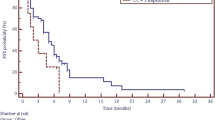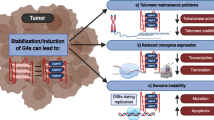Abstract
Purpose: Thymidylate synthase (TS) is one of the target molecules for the antitumor effects of fluoropyrimidine drugs. The cellular thymidylate synthase level is one of the determining factors for the antitumor activity of fluoropyrimidines. TYMS, which encodes TS, has been reported to possess 28-bp tandem repeat sequences in its 5′-untranslated region, the number of which varies. In addition, single nucleotide polymorphisms have also been shown in a triple repeat sequence. In this study, correlation between the polymorphic tandem repeat sequences of the TYMS gene and the antitumor activities of 5-fluorouracil (5-FU) and 5-fluoro-2′-deoxyuridine (FUdR) were investigated with 30 established human cell lines derived from solid tumors. Methods: A reporter assay system was developed in order to compare the ability of the transactivation mediated by the double (2R) and triple (c- or g-type, 3Rc or 3Rg, respectively) repeat sequences using a human colon cancer cell line, DLD-1. The 50% inhibitory concentration (IC50) of cell growth by 5-FU and FUdR was measured with 30 different established cell lines of human solid tumors. Genotypes based on the number of the 28-bp TYMS tandem repeat for the above cell lines were determined by electrophoretical analysis of PCR products containing the repeat sequences and nucleotide sequencing. Results: The reporter activity mediated by the 3Rg sequence was significantly higher than that by the 2R and 3Rc sequences. Activities mediated by the 2R and 3Rc sequences were comparable. According to the reporter assay, 2R and 3Rc were judged as low TS expression alleles and 3Rg as a high TS expression allele. On the basis of IC50 values, cells possessing the 2R/2R and 2R/3R repeat of TYMS were significantly more sensitive to FUdR than those with the 3R/3R repeat. Cells possessing 3Rg/3Rg (a high TS expression genotype) were significantly less sensitive to FUdR than cells with 2R/2R, 2R/3Rc, and 3Rc/3Rc (low TS expression genotypes). Conclusions: Our results of the reporter assays using 2R, 3Rc, and 3Rg repeat sequences prompted us to classify 3Rg as a high TS expression allele, and 2R and 3Rc as low TS expression alleles. The cells with low TS expression alleles were shown to exhibit significantly higher FUdR sensitivity than the cells with high TS expression alleles for the first time. These results were consistent with numerous previous in vitro and in vivo findings that tumors showing high TS expression were less sensitive to fluoropyrimidines. These results support the idea that genotyping the tandem repeat sequences of TYMS in the 5′-untranslated region is useful for individualized therapy involving fluoropyrimidine antitumor drugs.





Similar content being viewed by others
References
Chen J, Hunter DJ, Stampfer MJ, Kyte C, Chan W, Wetmur JG, Mosig R, Selhub J, Ma J (2003) Polymorphism in the thymidylate synthase promoter enhancer region modifies the risk and survival of colorectal cancer. Cancer Epidemiol Biomarkers Prev 12:958–962
Chu E, Drake JC, Koeller DM, Zinn S, Jamis-Dow CA, Yeh GC, Allegra CJ (1991) Induction of thymidylate synthase associated with multidrug resistance in human breast and colon cancer cell lines. Mol Pharmacol 39:136–143
Edler D, Glimelius B, Hallstrom M, Jakobsen A, Johnston PG, Magnusson I, Ragnhammar P, Blomgren H (2002) Thymidylate synthase expression in colorectal cancer: a prognostic and predictive marker of benefit from adjuvant fluorouracil-based chemotherapy. J Clin Oncol 20:1721–1728
Edler D, Hallstrom M, Johnston PG, Magnusson I, Ragnhammar P, Blomgren H (2000) Thymidylate synthase expression: an independent prognostic factor for local recurrence, distant metastasis, disease-free and overall survival in rectal cancer. Clin Cancer Res 6:1378–1384
Fujii R, Seshimo A, Kameoka S (2003) Relationships between the expression of thymidylate synthase, dihydropyrimidine dehydrogenase, and orotate phosphoribosyltransferase and cell proliferative activity and 5-fluorouracil sensitivity in colorectal carcinoma. Int J Oncol 8:72–78
Grem JL, Danenberg KD, Behan K, Parr A, Young L, Danenberg PV, Nguyen D, Drake J, Monks A, Allegra CJ (2001) Thymidine kinase, thymidylate synthase, and dihydropyrimidine dehydrogenase profiles of cell lines of the National Cancer Institute’s Anticancer Drug Screen. Clin Cancer Res 7:999–1009
Habara K, Ajiki T, Kamigaki T, Nakamura T, Kuroda Y (2001) High expression of thymidylate synthase leads to resistance to 5-fluorouracil in biliary tract carcinoma in vitro. Jpn J Cancer Res 92:1127–1132
Higashiyama M, Kodama K, Yokouchi H, Takami K, Fukushima M, Minamigawa K, Takano T, Kobayashi H (2001) Thymidylate synthase and dihydropyrimidine dehydrogenase activities in non-small cell lung cancer tissues: relationship with in vitro sensitivity to 5-fluorouracil. Lung Cancer 34:407–416
Horie N, Aiba H, Oguro K, Hojo H, Takeishi K (1995) Functional analysis and DNA polymorphism of the tandemly repeated sequences in the 5′-terminal regulatory region of the human gene for thymidylate synthase. Cell Structure and Function 20:191–197
Iacopetta B, Grieu F, Joseph D, Elsaleh H (2001) A polymorphism in the enhancer region of the thymidylate synthase promoter influences the survival of colorectal cancer patients treated with 5-fluorouracil. Brit J Cancer 85:827–830
Inaba M, Mitsuhashi J, Ozawa S (1990) Kinetic analysis of 5-fluorouracil action against various cancer cells. Jpn J Cancer Res 81:1039–1044
Ishida Y, Kawakami K, Tanaka Y, Kanehira E, Omura K, Watanabe G (2002) Association of thymidylate synthase gene polymorphism with its mRNA and protein expression and with prognosis in gastric cancer. Anticancer Res 22:2805–2810
Kaneda S, Nalbantoglu J, Takeishi K, Shimizu K, Gotoh O, Seno T, Ayusawa D (1990) Structural and functional analysis of the human thymidylate synthase gene. J Biol Chem 265:20277–20284
Kaneda S, Takeishi K, Ayusawa D, Shimizu K, Seno T, Altman S (1987) Role in translation of a triple tandemly repeated sequence in the 5′-untranslated region of human thymidylate synthase mRNA. Nucl Acids Res 15:1259–1270
Kawakami K, Ishida Y, Danenberg KD, Omura K, Watanabe G, Danenberg PV (2002) Functional polymorphism of the thymidylate synthase gene in colorectal cancer accompanied by frequent loss of heterozygosity. Jpn J Cancer Res 93:1221–1229
Kawakami K, Salonga D, Park JM, Danenberg KD, Uetake H, Brabender J, Omura K, Watanabe G, Danenberg PV (2001) Different lengths of a polymorphic repeat sequence in the thymidylate synthase gene affect translational efficiency but not its gene expression. Clin Cancer Res 7:4096–4101
Kawakami K, Watanabe G (2003) Identification and functional analysis of single nucleotide polymorphism in the tandem repeat sequence of thymidylate synthase gene. Cancer Res 63:6004–6007
Kubota T, Fujita S, Kodaira S, Yamamoto T, Josui K, Arisawa Y, Suto A, Ishibiki K, Abe O, Mabuchi K, Fuse M (1991) Antitumor activity of fluoropyrimidines and thymidylate synthase inhibition. Jpn J Cancer Res 82:476–482
Luo HR, Lu XM, Yao YG, Horie N, Takeishi K, Jorde LB, Zang YP (2002) Length polymorphism of thymidylate synthase regulatory region in Chinese populations and evolution of the novel alleles. Biochem Genet 40:41–51
Mandola MV, Stoehlmacher J, Muller-Weeks S, Cesarone G, Yu MC, Lenz HJ, Ladner RD (2003) A novel single nucleotide polymorphism within the 5′ tandem repeat polymorphism of the thymidylate synthase gene abolishes USF-1 binding and alters transcriptional activity. Cancer Res 63:2898–2904
Marsh S, Collie-Deguid ES, Li T, Liu X, McLeod HL (1999) Ethnic variation in the thymidylate synthase enhancer region polymorphism among Caucasian and Asian populations. Genomics 58:310–312
Marsh S, Ameyaw MM, Githanga J, Indalo A, Ofori-Adjei D, McLeod HL (2000) Novel thymidylate synthase enhancer region alleles in African populations. Hum Mutation 16:528–533
Marsh S, McLeod HL (2001) Thymidylate synthase pharmacogenetics in colorectal cancer. Clin Colorectal Cancer 1:175–178
Ma T, Zhu ZG, Ji YB, Zhang Y, Yu YY, Liu BY, Yin HR, Lin YZ (2004) Correlation of thymidylate synthase, thymidylate phosphorylase and dihydropyrimidine dehydrogenase with sensitivity of gastrointestinal cancer cells to 5-fluorouracil and 5-fluoro-2′-deoxyuridine. World J Gastroenterol 10:172–176
Mori K, Hasegawa M, Nishida M, Toma H, Fukuda M, Kubota T, Nagasue N, Yamana H, Hirakawa-YS Chung K, Ikeda T, Takasaki K, Oka M, Kameyama M, Toi M, Fujii H, Kitamura M, Murai M, Sasaki H, Ozono S, Makuuchi H, Shimada Y, Onishi Y, Aoyagi S, Mizutani K, Ogawa M, Nakao A, Kinoshita H, Tono T, Imamoto H, Nakashima Y, Manabe T (2000) Expression levels of thymidine phosphorylase and dihydropyrimidine dehydrogenase in various human tumor tissues. Int J Oncol 17:33–38
Myers CE (1981) The pharmacology of the fluoropyrimidines. Pharmacol Rev 33:1–15
Pullarkat ST, Stoehlmacher J, Ghaderi V, Xiong Y-P, Ingels SA, Sherrod A, Warren R, Tsao-Wei D, Groshen S, Lenz H-J (2001) Thymidylate synthase gene polymorphism determines response and toxicity of 5-FU chemotherapy. Pharmacogenomics J 1:65–70
Saga Y, Suzuki M, Mizukami H, Kohno T, Takei Y, Fukushima M, Ozawa K (2003) Overexpression of thymidylate synthase mediates desensitization for 5-fluorouracil of tumor cells. Int J Cancer 106:324–326
Salonga D, Danenberg KD, Johnson M, Metzger R, Groshen S, Tsao-Wei DD, Lenz HJ, Leichman CG, Leichman L, Diasio RB, Danenberg PV (2000) Colorectal tumors responding to 5-fluorouracil have low gene expression levels of dihydropyrimidine dehydrogenase, thymidylate synthase, and thymidine phosphorylase. Clin Cancer Res 6:1322–1327
Takenoue T, Nagawa H, Matsuda K, Fujii S, Nita ME, Hatano K, Kitayama J, Tsuruo T, Muto T (2000) Relation between thymidylate synthase expression and survival in colon carcinoma, and determination of appropriate application of 5-fluorouracil by immunohistochemical method. Ann Surgical Oncol 7:193–198
Tsuji T, Hidaka S, Sawai T, Nakagoe T, Yano H, Haseba M, Komatsu H, Shindou H, Fukuoka H, Yoshinaga M, Shibasaki S, Nanashima A, Yamaguchi H, Yasutake T, Tagawa Y (2003) Polymorphism in the thymidylate synthase promoter enhancer region is not an efficacious marker for tumor sensitivity to 5-fluorouracil-based oral adjuvant chemotherapy in colorectal cancer. Clin Cancer Res 9:3700–3704
Villafranca E, Okruzhnov Y, Dominguez MA, Garcia-Foncillas J, Azinovic I, Martinez E, Illarramendi JJ, Arias F, Monge RM, Salgado E, Angeletti S, Brugarolas A (2001) Polymorphisms of the repeated sequences in the enhancer region of the thymidylate synthase gene promoter may predict downstaging after preoperative chemoradiation in rectal cancer. J Clin Oncol 19:1779–1786
Yoshinare K, Kubota T, Watanabe M, Wada N, Nishibori H, Hasegawa H, Kitajima M, Takechi T, Fukushima M (2003) Gene expression in colorectal cancer and in vitro chemosensitivity to 5-fluorouracil: a study of 88 surgical specimens. Cancer Sci 94:633–638
Acknowledgements
This study was supported in part by the Program for the Promotion of Fundamental Studies in Health Sciences (MPJ-6) of the Pharmaceuticals and Medical Devices Agency (PMDA) of Japan and by a grant from the Human Science Foundation Japan. The authors thank Ms. Chie Knudsen for her secretarial assistance.
Author information
Authors and Affiliations
Corresponding author
Additional information
Ayako Yawata and Su-Ryang Kim contributed equally to the work.
Rights and permissions
About this article
Cite this article
Yawata, A., Kim, SR., Miyajima, A. et al. Polymorphic tandem repeat sequences of the thymidylate synthase gene correlates with cellular-based sensitivity to fluoropyrimidine antitumor agents. Cancer Chemother Pharmacol 56, 465–472 (2005). https://doi.org/10.1007/s00280-005-1018-z
Received:
Accepted:
Published:
Issue Date:
DOI: https://doi.org/10.1007/s00280-005-1018-z




